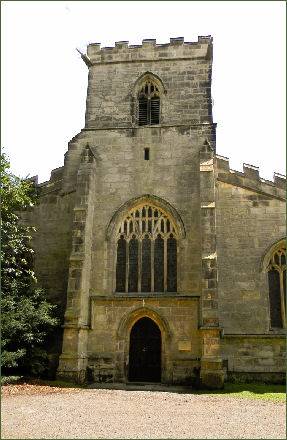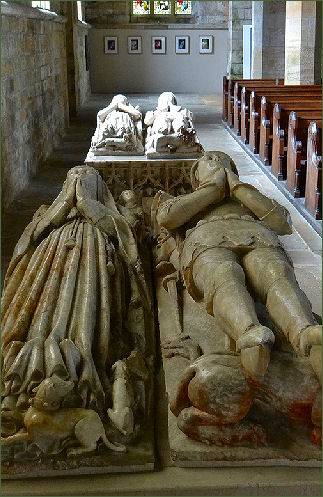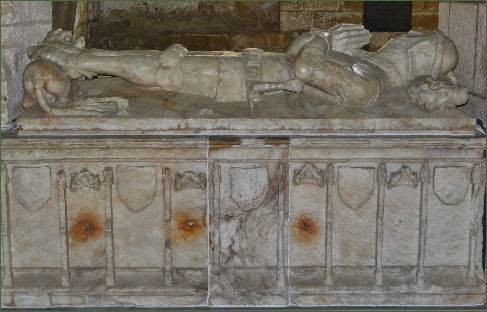All Saints Church, Harewood
OS grid reference:-SE 311 446
 Standing in the parkland of magnificent Harewood House, the Yorkshire seat of the Earl and Countess of Harewood, All Saints' church, a designated Grade I listed building, dates back to the fifteenth century.
Standing in the parkland of magnificent Harewood House, the Yorkshire seat of the Earl and Countess of Harewood, All Saints' church, a designated Grade I listed building, dates back to the fifteenth century.
The church was constructed in around 1410 by Elizabeth and Sybil, the daughters of William de Aldburgh of the nearby Harewood Castle, and was originally dedicated to the Holy Cross. It was not the first church to occupy the site. There is a record of a priest here in the tenth century.
 In 1739 the estate was acquired by the Lascelles family, who in later generations became the Earls of Harewood, and in 1759 they began the building of Harewood House. In the early 1780s the family added battlements and pinnacles to the church.
In 1739 the estate was acquired by the Lascelles family, who in later generations became the Earls of Harewood, and in 1759 they began the building of Harewood House. In the early 1780s the family added battlements and pinnacles to the church.
The building was restored in 1862-63 by Sir George Gilbert Scott.The restoration included replacement of the ceiling, the pews and the stained glass, and adding a new altar, lectern, pulpit and font.
It is remarkable for six pairs of effigies, dating from 1419 to 1510, described as being "the glory of the church", these depict the owners of Harewood and the nearby Gawthorpe estate. They are some of the greatest surviving examples of alabaster carving, virtually without rival in England and offer a fascinating glimpse into the amour, robes, jewellery and headdresses of the day.
The earliest depicts the judge William Gascoigne and his first wife, Elizabeth Mowbray, Cascoigne is in the robes of the Lord Chief Justice with a finely carved purse on one side and a dagger on the other. Elizabeth wears a full wide sleeved gown with a high girdle, and is depicted in an elaborate headdress. Roses and leaves form a chaplet which passes over two side templar nets an a veil. Centred on the front of the chaplet is a pelican badge showing traces of gilding. Her feet rest on a little dog.
The next pair of effigies date from 1426, and depict Richard Redmond and his wife, Elizabeth Aldborough. Richard lies in armour, Elizabeth's costume is notable for a heart pendant and the flower sprigged templar nets of her headdress. The next pair are similar in date and style, depicting William Rayther (pictured below left) and his wife Sybil Aldborough, sister to Elizabeth.
The next couple sees another William Gascoigne, grandson to the judge, with his wife Margaret Clare (pictured right). Gascoigne is armoured, Margaret is dressed as a widow in a simple gown and mantle. The fifth pair of effigies date from1487 and are of another William Gascoigne and his wife Mary Percy. Mary is also dressed as a widow, in gown and mantle.
 Each subsequent tomb shows greater and greater sophistication in the carving and the detail of costume. The latest, of Edward Redman, is thought to be a true likeness of the man,which was rare in Medieval times. At his feet is a tiny but perfectly carved figure of a bedesman who is shown saying prayers for the soul of the departed.
Each subsequent tomb shows greater and greater sophistication in the carving and the detail of costume. The latest, of Edward Redman, is thought to be a true likeness of the man,which was rare in Medieval times. At his feet is a tiny but perfectly carved figure of a bedesman who is shown saying prayers for the soul of the departed.
On the north wall is a much more modern memorial, to the 6th Earl of Harewood and his wife, HRH Princess Mary, the only daughter of George V and Queen Mary of Teck..
The church contains two fonts; one is Norman and the other dates from the Victorian era. The octagonal pulpit dates from the nineteenth century and contains marble columns and carved stone panels. The altar rails and gates are a memorial to King George V and include the insignia of the Order of the British Empire, Order of the Garter, Order of the Thistle and Order of St Patrick.
There are fragments of original fourteenth century stained glass, offering a contrast to the late Victorian glass in the west window, the work of the famous Kempe studio.
The church was restored in 1862-63 by Sir George Gilbert Scott, designer of St Pancras Station, the Albert Memorial and many churches. The interior has an unadorned simplicity and there is a fine west window. All the monuments were originally brightly coloured, but the colour has faded, leaving the white alabaster.
By 1978 the effigies on the alabaster monuments were deteriorating and the church was taken into the care of the Churches Conservation Trust, who restored and repairs were carried out to the fabric of the church. All Saints was declared redundant on 1 November 1977, and was vested in the Trust on 24 October 1978. Excavations on the site have unearthed numerous early medieval artefacts, including a carved panel thought to be Anglo-Danish (pre-Conquest), and twelfth century column shafts.
Abbeys and Churches of Yorkshire
